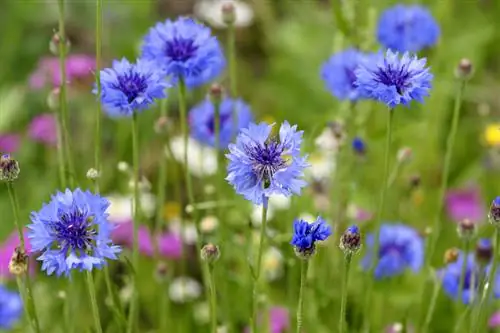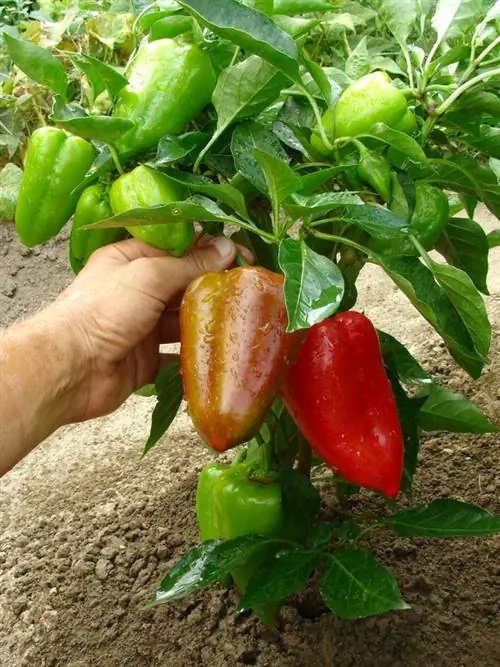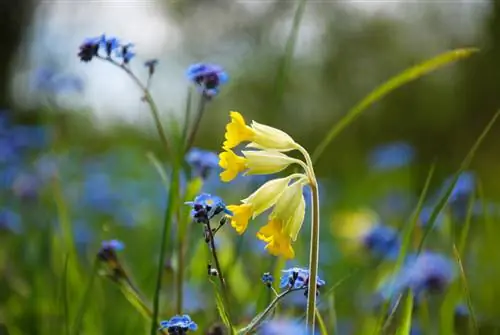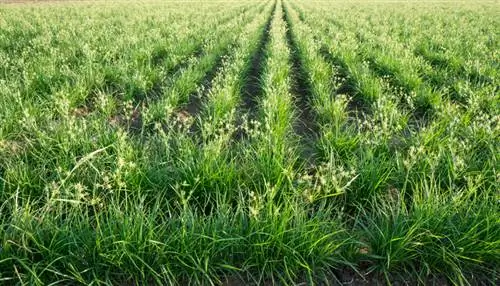- Author admin [email protected].
- Public 2023-12-25 17:45.
- Last modified 2025-06-01 06:02.
The cornflower impresses as a distinctive summer flower with a fantastic long-distance effect. Thanks to its natural grace, the bright blue cyan is a welcome guest in country house gardens and natural flower beds. How you can skillfully cultivate the romantic beauty of flowers in your green kingdom is no longer hidden from you here. The following answers to frequently asked questions show how it works.
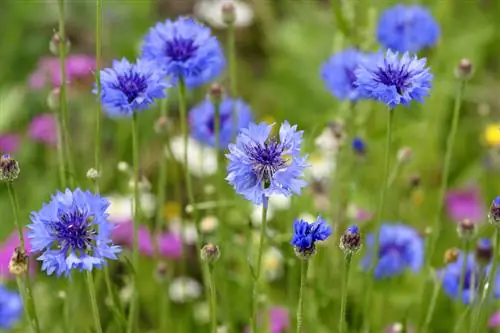
How to care for a cornflower in the garden?
Cornflower (Centaurea cyanus) is a summer annual flower that thrives in full sun and requires moderate watering. It prefers sandy-loamy, well-drained soil and can be propagated by sowing. Its bright blue flowers are edible and offer a long bloom period from April to October.
Planting cornflowers correctly
Plant a cyan that has been grown on the windowsill or purchased from a garden center in a sunny, warm location from mid to late April. To create a picturesque appearance, we recommend an arrangement in small tuffs with 5-10 young plants. To do this, dig small planting pits at a distance of 20 cm that are half the diameter of the root ball. Instead of compost or other fertilizer, add some sand or fine grit to the excavation if the consistency of the garden soil seems too firm to you. Plant a potted cornflower in each hole and fill in the excavation up to just below the first pair of leaves. Water regularly on the day of planting and thereafter until the cyanide is established.
Care tips
In terms of undemanding care, the cyan is undoubtedly one of the best in its class among summer flowers. Here's how to do it correctly:
- Watering sparingly without watering the flower
- Fertilizing is not necessary
- Clean up wilted flowers regularly
- Protect long-stemmed varieties from wind throw with a support rod
If you leave a few wilted cornflowers in the bed in late summer, they will take care of their propagation by self-sowing. Next spring the next generation of these atmospheric summer flowers will appear - as if by magic.
Which location is suitable?
In the full sun, warm location, the cornflower shows in all its colorful splendor why it is considered a symbol of mid-summer flower beauty. A place in light shade is tolerated, but results in a less wasteful flowering. While the compact wild species Centaurea cyanus also knows how to cope with windy locations, the long-stemmed cyanide hybrids prefer a location protected from wind and rain.read more
The correct planting distance
The slender shape of a cyan requires a planting distance of 15-20 cm in the row. This value probably applies to the long-stemmed as well as the compact varieties. You are also well advised to use a row spacing of 20 cm. Only under the special conditions in the balcony box do you reduce the value by 5 cm to create the dense and lush appearance.
What soil does the plant need?
The cornflower finds ideal conditions in lean, sandy-loamy and well-drained soil. So choose a place in the rock garden, the gravel bed or in the natural wild herb bed. You can easily adapt firm, loamy-clay soil to the needs of a cyanide by incorporating sand, fine chippings or gravel. Excessively dry soil is optimized with the help of compost, leaf mold or bark humus. For cultivation in pots, this means that a rather lean substrate makes sense, such as standard soil or pricking soil.
What is the best time to plant?
The seeds of a cyanide are frost-resistant, but this does not apply to early young plants. For the delicate summer flowers, the planting time only begins when there is no longer any fear of ground frost. Experience has shown that a date from the beginning/mid of May can be considered, but not without first consulting the weather report.
When is flowering time?
In April, the blue flowers of the wild cornflower prepare us for a long flowering period that lasts until October. In May and June, the refined hybrids follow the good example and also develop their colorful, often double flowers. Since a single flower does not last for this long period, please cut off withered stems. The next buds are already waiting underneath to open.read more
Cutting cornflowers correctly
If you consistently cut off withered flower stalks, the flowering period will extend well into autumn. If you don't want to chase after every single dead cyan, cut off all the tuff down to the basal leaves at the end of the first flowering period. A lush re-bloom then appears, the pruning of which motivates a vital plant to produce a third round of blooms.
Watering cornflower
A moderate water supply meets the wishes of a cyanide. In concrete terms, this means that you only water the flower when the soil is completely dry. If you don't get ahead of a rain shower, pour the water from the can spout directly onto the root disk. The watering can is more often used for a cornflower in a pot, as the substrate dries out quickly in a sunny location. A quick thumb test in the morning ensures whether there is actually a need for watering. Please pour out a saucer after a quarter of an hour at the latest to prevent waterlogging.
Fertilize cornflowers properly
The frugal cyanide is not fertilized during its one-year lifespan. This also applies to cornflowers in pots or flower boxes, as commercially available substrates are usually sufficiently pre-fertilized. The only exception is very poor, stony soil. Here in June you can awaken the floral spirit with a portion of compost and horn shavings.
Diseases
Under the influence of warm, humid weather, cyanide can be affected by powdery mildew. The unmistakable symptom of this widespread fungal infection is white deposits on the top and bottom of the leaves. In view of the easy sowing and rapid germination of the seeds, extensive control measures make little sense. Dig up the diseased cornflowers and sow again without further ado. As a preventive measure, we recommend avoiding overhead irrigation as part of the water supply.
Wintering
A cyanide thrives as a winter annual or summer annual flower. Cornflowers sown in autumn overwinter as fruits or young plants in the bed without any special precautions having to be taken. After flowering and seed formation, they die, regardless of whether they were sown in autumn or spring.
Propagate cornflowers
The simplest method of propagating cornflowers is by sowing. Since the seeds - in contrast to the flowers - are hardy, there is nothing wrong with direct sowing in April/May or August/September. To do this, plant a fine, crumbly seedbed in sandy, lean soil in a sunny, warm location. Sow the seeds 20 cm apart in rows and then sift them 0.5 cm high with sand or vermiculite. Moistened with a fine spray and protected with a close-meshed net, germination progresses quickly. At 12-18 degrees Celsius, the first cotyledons emerge after 1-2 weeks. If there is a lot of space in the bed, separate the strongest seedlings at a distance of 15-20 cm as soon as they have at least 2 pairs of leaves.
Cornflower in a pot
In the pot and balcony box, the intensely bright cornflowers catch the eye from afar. As a substrate, we recommend potting soil with sand, standard standard soil or the most suitable potting soil. Only fill the substrate into the container after placing a piece of clay over each water drain as drainage. Unpot the young plants to plant them 10-12 cm apart. After you have pressed the soil, water it with a good sip of water. From now on, caring for a cyanide will take little effort. Where no rain reaches the soil, water moderately. Please cut out wilted flowers regularly so that the next buds can find their way to sunlight. The humble flower does not require additional nutrients as the soil is already pre-fertilized.
Is cornflower poisonous?
Anything that shines as intensely in the garden as a cyanide should generally be treated with caution. In this case we can of course give the all-clear. The cornflower owes its blue colors to a completely harmless ingredient cyanidin, which is also responsible for the striking color in red cabbage or blackberries, for example. The pretty, fuzzy flowers are even edible. In light summer cuisine, creative chefs use the flowers as decoration for cold and warm dishes.read more
Trivia
In search of the origin of their various names, embark on a journey into the distant past. The botanical name Centaurea cyanus most likely refers to a centaur from Greek mythology. One of these hybrid creatures of man and horse was named Chiron. This half-brother of Zeus was knowledgeable in medicine and used cornflowers to heal a wound on the foot of the legendary Achilles. Furthermore, Ceres, the goddess of the harvest, wore a cornflower in her hair.
Beautiful varieties
- Red Lola: The cyan impresses with red, lush double flowers and a long flowering period from May to September; 80-90cm
- Black Beauty: A rare Centaurea cyanus with dramatic black double flowers from June; 70-80cm
- Snowman: White-flowering cornflower that harmonizes wonderfully with its colored counterparts; 70-100cm
- Blue Double: A beautiful variant of the blue wild variety that features semi-double flowers; 50-70cm
- Blue Boy: Premium variety, with unmistakable, deep blue and double flower heads; 50-60cm
- Red Boy: The deep red counterpart to the Blue Boy for intense color accents in the summer garden; 70-80cm
- Classic Fantastic: Enchanting mixture in every conceivable shade of blue, filled and unfilled; 50-100cm

